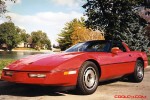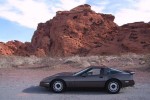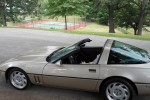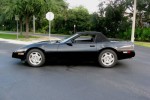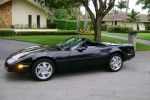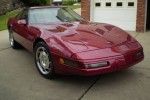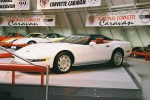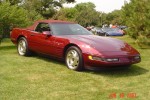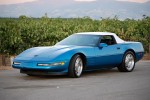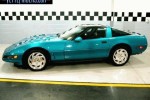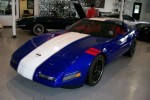This summer, we are talking “Generations”. Every week we’ve highlighted another Generation of Corvette. We have pictures, videos, and some great reading material on each Generation of Corvette. In this post, we look at the C4.
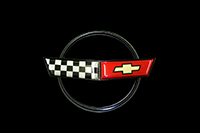
Hey, what happened to 1983? What happened was that the change from the previous-generation Corvette to the new one was so radical that it took a while to get the Bowling Green plant up and running. So while 43 preproduction “1983” C4 Corvettes were built, none of these was ever sold to the general public and only one of them survives today. Instead, in March of ’83, Chevrolet began selling the 1984 Corvette and it was the most dramatically different Corvette since the ’63 Sting Ray.
This new machine rode on a 96.2-inch wheelbase, used simply gorgeous cast aluminum suspension components and featured a larger interior with fully digital instrumentation that looked as if it had been ripped off a Star Trek movie set. One of the particularly cheesy and unconvincing Star Trek movie sets.
Gone were the old coupe’s T-tops in favor of a single fiberglass section that could be removed using a wrench, but many of the C3 styling themes continued, though more conservatively expressed. The hideaway headlights were now single square units on rotating mounts, and the hood itself was a giant clamshell piece that made access to the engine easy but appalled insurance companies that had to cover its enormous replacement cost.
Everything mechanical about the C4 Corvette was significantly better than before. The new suspension system used composite transverse leaf springs both fore and aft, the steering was by rack-and-pinion for the first time, the brakes were oversized discs, the frame itself featured a large aluminum C-section beam that made for a stiffer structure and the tires were enormous (for the time) Goodyear P255/50VR16 unidirectional “Gatorbacks” on 16-inch wheels. About the only thing that carried over was the small-block 350 V8, again equipped with Cross-Fire throttle-body fuel injection and now rated at 205 hp.
At the beginning of the 1984 model run, the only transmission available was the 700R4 four-speed automatic, but by January of 1984 a new Doug Nash “4+3” manual transmission was offered that featured an electronically engaged overdrive on the top three gears. Although intriguing, it was a balky and completely crummy excuse for a transmission.
The major criticisms of the ’84 Corvette were its incredibly stiff ride, particularly when equipped with the Z51 performance suspension package, the still-lackluster engine and the obnoxious dash graphics. Despite that, however, the ’84 Corvette quickly established itself as the dominant car in showroom stock racing and Chevrolet sold a stunning 53,877 of them during the extended model year.
Messing with success where needed, the Corvette was treated to the new Tuned Port Injected (TPI) version of the 350-cubic-inch (now more commonly referred to as a 5.7-liter) small-block for 1985. This vastly more efficient induction system bumped output of the V8 to 230 hp with a thick and friendly torque curve. The better “L98” engine was combined with a retuned, more comfortable suspension to produce a significantly better Corvette than the previous year.
A convertible returned to the Corvette lineup for 1986 and a bright yellow version was used to pace that year’s Indianapolis 500: the second time a Corvette had had the honor. Another significant advance was the fitment of Bosch antilock brakes for the first time, making for a safer everyday machine. Every Corvette coupe also got a third brake light over its rear hatch, while the convertible’s was integrated into the rear fascia. Chevy sold 27,794 ’86 Corvette coupes and 7,315 convertibles.
The fitment of hydraulic roller lifters to the L98’s valvetrain boosted its output to 240 hp for 1987, but the car was virtually unchanged otherwise. Two interesting additions to the options list were a new Z-52 suspension system for higher performance without the complete sacrifice of comfort, and new electronic tire-pressure monitors.
New 17-inch wheels inside P275/40ZR17 tires were added to the 1988 Corvette options list, while new aluminum cylinder heads and a revised camshaft boosted the L98 to 245 hp with even better torque characteristics. This was also the last year Chevy would foist the dreadful 4+3 transmission off as the shift-it-yourself choice. A 35th anniversary model, done in a white-on-white scheme, marked this milestone.
The new manual transmission for 1989 was a ZF six-speed that was a joy to shift as long as you didn’t mind using some muscle. And as long as you didn’t resent the “skip shift” feature that forced a shift from 1st to 4th gear under part-throttle conditions to improve fuel economy. Other changes to the lineup included a new FX3 selective ride control system for the Z51-equipped coupes and a new optional fiberglass hardtop for the convertible. Every enthusiast knew, however, that much bigger, much brawnier news was coming to the Corvette for 1990.
That big news was, of course, the 1990 Corvette ZR-1 coupe (the ZR-1 was never available as a convertible). Nicknamed “King of the Hill,” the ZR-1 was built around the Lotus-designed, Mercury Marine-built, all-aluminum 5.7-liter DOHC 32-valve LT5 V8 making an astounding 375 hp. That is, it made 375 hp when an in-dash key was set in “full-power” mode and not in the “valet” mode, where it was limited to just 250 hp. The only transmission available in the ZR-1 was the ZF six-speed and inside its swollen rear fenders were humongous P315/35ZR17 tires on suitably wide wheels.
The widened rear fenders on the ZR-1 were capped by a new rear fascia distinguished by squared-off taillights and convex (as opposed to the usually concave) rear fascia.
In testing a preproduction ZR-1, Motor Trend concluded that, “With a top speed in the neighborhood of 175 mph, a 0-60-mph time of 4.71 seconds and 13.13-second/110.0-mph quarter-mile, no one’s going to accuse the DOHC ‘Vette of being limp-wristed.” They were right, no one dared call the limited-production ZR-1 limp-wristed, but it was criticized for its incredible $58,995 price: nearly twice that of a regular L98-powered Corvette.
All the ’90 Corvettes got a new dashboard with a vastly improved mixture of analog and digital instrumentation, better ventilation, better sound systems and an airbag for the driver. Otherwise, the Corvette was very much status quo.
Restyling came to the Chevrolet Corvette for 1991 with a slicker front end incorporating wraparound foglights, a new rear fascia reminiscent of the ZR-1’s that incorporated the third brake light (the latter would remain on the hatch of the ZR-1) and new wheels. Everything else was pretty much a carryover, though the price of the ZR-1 had now ballooned to $64,138, making it the first GM automobile to carry a price beyond $60,000.
For 1992, the L98 was dumped in favor of the new next-generation small-block V8, the LT1 (no hyphen, unlike the ’70 version with the similar name). The LT1 was rated at 300 hp thanks to significant revisions to the cylinder heads, accessory drives, cooling system and fuel injection. But despite that healthy increase in output, it was also an even more engaging driving companion than the L98. Along with the LT1 came traction control — Acceleration Slip Regulation (ASR in GM speak) — whose best feature was that it could be turned off.
On July 2, 1992, the millionth Chevrolet Corvette, a white ’92 convertible, was built.
A special 40th anniversary package, consisting mostly of badges and special Ruby Red paint, was offered for 1993 on both LT1 and ZR-1 Corvettes. Otherwise, the most notable change for the year was refinement of the LT5 engine in the ZR-1 that boosted its horsepower from 375 to an epic 405: in real-world terms (accounting for the difference between the old SAE gross and current SAE net rating methods), the most powerful production Corvette up to that time. Other changes were minimal.
An airbag was added for passengers in the 1994 Corvettes, while the cockpit’s trim and steering wheel were refined. The LT1 was treated to sequential fuel injection that improved drivability and simplified emissions control but didn’t increase total power output. The ZR-1 got new five-spoke wheels, but that’s about it.
New side gills distinguished the 1995 Corvette from previous editions, but other changes were much more subtle and included improved brakes, revised springs, de Carbon gas-charged shocks and a quieter-running engine fan. And for the third time, a Corvette (this time a convertible) paced the Indy 500.
It was also the last year for the ZR-1. “When the LT5’s throttle body opens into the 16 tuned intake runners (assuming the power key is twisted to ‘full’),” Motor Trend’s intrepid scribe wrote in its last ZR-1 test, “it humps.” Beyond hazing the P315/35ZR17 Goodyear Eagle GS-Cs under the car’s trademark swollen flanks when accelerating, it bursts down the quarter-mile in 13.05 seconds at over 117 mph. Getting to 60 from rest takes only 4.9 seconds, and getting from 60 to 100 takes only 4.8 more. The midrange power is even better than the Ferrari F355’s.
“The engine is sophisticated, but the sound of it and the transmission could only be more involving if the driver sat in the crankcase. The ZR-1’s mechanical character thrills in an era when so many cars isolate their occupants. Like all current Corvettes, the handling limits are high, but the ZR-1’s larger tires mean that once those limits have been exceeded that it’s even tougher to rein in. And, like all current Corvettes, the cockpit is a challenge to enter and cramped once inside.”
For 1996, Chevy followed up the ZR-1 with two unique editions that would mark the end of C4 production. The first was a “Collector’s Edition” available on coupes and convertibles that consisted mostly of special emblems, five-spoke wheels and Sebring Silver paint. Far more intriguing was the Grand Sport, which swiped its name and blue-with-white-stripe paint job from an early-’60s racing Corvette and featured an amplified version of the LT1 small-block called the “LT4” that made a healthy 330 hp. A debate still rages on whether the ZR-1 or Grand Sport best expressed the essence and potential of the C4 Corvette.
What was obvious, however, was that it was time for a new Corvette.
Content (except pictures and video): Edmunds

